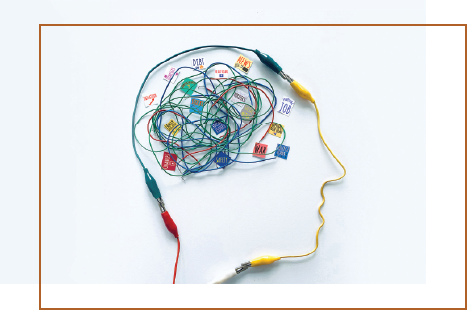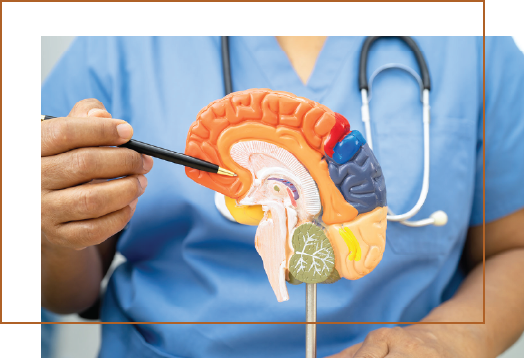Huperzine A
Huperzine A is a natural acetylcholinesterase inhibitor found in the moss Huperzia serrata that has been used in Chinese medicine for centuries. It has gained popularity as a nootropic to enhance memory, and is highly regarded for its neuroprotective properties.3,4
Noopept
Noopept is a cognitive-boosting compound. It increases expression of both BDNF and NGF genes, making it supportive of normal memory retrieval and memory consolidation.5 It has shown beneficial effects on cognitive functions in mild cognitive impairment associated with APOE ε4.6
Polygala tenuifolia
Also known as Yuan Zhi in Chinese Medicine, it is rich in triterpene saponins, including onjisaponins and polygalasaponins, and it shows protective effects on the central nervous system, commonly used for memory dysfunction, insomnia, and neurasthenia.7–9 It has been shown to improve learning and memory via increasing BDNF (Brain Derived Neurotrophic Factor) expression.9,10 Onjisaponins in P. tenuifolia enhance production of NGF (nerve growth factor), a protein that helps neurons grow, survive, and maintain themselves.11 P. tenuifolia increases GABA and decreases levels of dopamine and DRD2 expression, which can provide a calming effect on the nervous system.12
DMAE Bitartrate
DMAE Bitartrate (Dimethylaminoethanol Bitartrate) is a cholinergic compound that supports neurofunction, cognition, and brain health by enhancing acetylcholine synthesis and neurotransmission. It has been used to treat mild cognitive impairment and is believed to increase choline levels, aiding in memory and attention. DMAE may also genetically regulate catecholamine neurotransmitters such as dopamine (SLC6A3) and norepinephrine (SLC6A2), which contribute to mood and focus. Additionally, it has shown potential in modulating adrenergic responses, influencing neuronal signaling pathways. These properties make DMAE a potential cognitive enhancer, particularly for age-related cognitive decline.13–16
Phellodendron amurense
Also known as Cork Tree, a traditional Chinese botanical, Phellodendron amurense has shown promising neurological benefits, particularly in neuroprotection and memory enhancement. It protects against neurotoxicity by modulating cell viability and reducing apoptosis, making it a potential treatment for Alzheimer’s disease. Additionally, its main alkaloid, berberine, improved memory deficits in rats by enhancing cholinergic activity and reducing pro-inflammatory cytokines in the hippocampus.17 The extract also exhibits strong anti-inflammatory and antioxidant effects, further protecting neurons from damage related to oxidative stress.18
Gastrodia elata
Gastrodia elata, commonly known as Tianma, is a traditional herbal medicine widely used in East Asia for neurological health. Research suggests it has neuroprotective properties, safeguarding neuronal cells and aiding brain recovery by reducing oxidative stress and inflammation, and regulating apoptosis pathways. Additionally, it has been explored for its potential role in neurodegenerative disease treatment, offering promise in neuronal protection and brain function recovery in preclinical models. Studies also indicate its potential to enhance cognitive function, with evidence showing it may improve spatial memory and maintain hippocampal balance.19,20
Vinpocetine
Vinpocetine, a compound derived from the periwinkle plant, supports neurocognitive health by enhancing cerebral blood flow, neuroprotection, and neurotransmitter function. It acts as a vasodilator, through inhibition of phosphodiesterase-1 (PDE1), leading to increased cyclic GMP levels and subsequent vasodilation, improving oxygen delivery to the brain. Additionally, its antioxidant and anti-inflammatory properties help reduce oxidative stress and neuronal damage. Clinical studies also suggest benefits for vascular dementia, mild cognitive impairment, and Alzheimer’s disease.21–23
N-Acetyl-L-Tyrosine
N-Acetyl-L-Tyrosine is a derivative of the amino acid L-tyrosine, which serves as a precursor to key neurotransmitters such as dopamine, norepinephrine, and epinephrine. These neurotransmitters are essential for regulating mood, cognitive functions, and the body’s response to stress. Tyrosine effectively enhances cognitive performance, particularly in short-term stressful and/or cognitively demanding situations.24
Alpha-GPC (Glyceryl Phosphoryl Choline)
Alpha-GPC is a compound that enhances neurocognitive health by increasing acetylcholine levels, a neurotransmitter vital for memory, learning, and neuroplasticity. It supports neuronal growth and repair, protects against oxidative stress, and may slow cognitive decline in Alzheimer’s disease and dementia. Research suggests it improves memory retention, focus, mental clarity, and brain metabolism by boosting blood flow and oxygen delivery.25,26
Magnolia officinalis
Magnolia officinalis, rich in bioactive compounds like magnolol and honokiol, has shown neuroprotective effects that may benefit neurocognitive health. Research suggests it can reduce neuroinflammation, protect neurons, enhance cognitive function, and disrupt beta amyloid plaques, particularly in conditions like Alzheimer’s disease and white matter injury. Studies indicate that magnolol improves cognitive deficits, while honokiol supports myelin repair and reduces cognitive decline.27–29
Phosphatidylserine
Phosphatidylserine is crucial for brain health, supporting memory, cognition, mood, and neuroprotection by maintaining neuronal integrity, enhancing neurotransmission, and mitigating oxidative stress. PTDSS1 and PTDSS2 encode phosphatidylserine synthases, essential for phosphatidylserine biosynthesis, with deficiencies linked to neurodegeneration. The FOXO3 gene, homologous to DAF-16, regulates oxidative stress responses, apoptosis, and longevity, contributing to cognitive resilience and its neuroprotective properties. Dysregulation of these genes is associated with cognitive decline and age-related neurological disorders, underscoring the significance of PS metabolism in brain function.30–32
Bacopa monnieri
Also known as baobab tree fruit, Bacopa monnieri is a nootropic herb that enhances cognition, memory, and neuroprotection by modulating key neurotrophic factors and reducing inflammation. It upregulates BDNF and NGF expression, promoting synaptic plasticity and neurogenesis, while also interacting with ApoE receptors, influencing synaptic modulation. It enhances BDNF-TrkB signaling for hippocampal neurogenesis and reduces neuroinflammation via NF-κB downregulation. Bacopa has also been shown to indirectly influence dopamine and serotonin systems, and its CREB phosphorylation activity further supports memory formation. These effects make Bacopa a promising potential therapy for cognitive decline and neurodegenerative diseases.33–37
Skullcap
Scutellaria lateriflora (American Skullcap) is a neuroprotective herb with anxiolytic and antioxidant properties, attributed to its flavonoids baicalein, baicalin, wogonin, and scutellarin. It is reported to reduce anxiety and oxidative stress, while protecting DNA and regulating flavonoid biosynthesis genes like SlPAL, SlC4H, Sl4CL, SlCHS, and SlCHI, all contributing to its therapeutic effects. Scutellarin also modulates the JNK/Caspase-3 pathway, suggesting a potential role in neurodegenerative and oncological treatments, while Skullcap’s inhibition of prion protein aggregation highlights its neuroprotective potential.38–41
Centella asiatica
Also known as Gotu Kola. Centella asiatica is a neuroprotective and cognitive-enhancing herb that supports memory, mood, focus, and overall brain health. It enhances mitochondrial function, reduces oxidative stress, and promotes synaptic plasticity through NRF2-regulated antioxidant pathways. It also modulates BDNF levels, improving neurogenesis and synaptic density. Additionally, it has been reported to influence NAD+, purine, and glycerophospholipid metabolism, which help maintain brain energy balance. Active compounds like asiatic acid and madecassoside reduce neuroinflammation and amyloid-β pathology, making it a potential therapeutic option for neurodegenerative conditions. Centella asiatica also promotes early neuronal differentiation, axonal outgrowth, and synaptic formation, further highlighting its neurotrophic benefits.42–46
Ginkgo biloba
Ginkgo biloba is a nootropic herb with neuroprotective and cognitive-enhancing properties, improving memory, attention, and mood by modulating neurotransmitter levels on a genetic level, including dopamine through DRD2, noradrenaline via SLC6A2, serotonin through SLC6A4, and acetylcholine via CHRNA4 in the prefrontal cortex. It reduces oxidative stress via SOD1, SOD2, CAT, and GPX1, inhibits beta-amyloid accumulation via APP and BACE1, and enhances cerebral blood flow, making it beneficial for neurodegenerative conditions such as Alzheimer’s disease. Ginkgo biloba upregulates BDNF, HMOX1, and mitochondrial genes like MT-CO3 and MT-ND1, supporting neuroprotection and synaptic function. Additionally, Ginkgo biloba modulates stress response genes, like HSPA1A and NFKB1, and enhances cholinergic signaling by regulating the expression of genes like CHAT and CHRNA7, which contributes to cognitive resilience and mental clarity.47–51
Alpha-Ketoglutaric Acid
Alpha-ketoglutaric acid is a key metabolite in the tricarboxylic acid (TCA) cycle that supports neurofunction, cognition, and brain health by enhancing mitochondrial activity, reducing oxidative stress, and regulating neurotransmitter balance. It has been shown to protect mitochondrial DNA from damage and modulate the alpha-ketoglutarate dehydrogenase complex, a crucial enzyme for ATP production that is often impaired in neurodegenerative diseases. Alpha-ketoglutaric acid also influences glutamate metabolism by affecting the expression of genes like GLUD1, SLC1A3, and SLC1A6, which helps regulate excitotoxicity. Additionally, it has been reported to reduce lipid peroxidation, prevent seizure-induced mitochondrial dysfunction, and extend lifespan by reducing neuroinflammation and supporting metabolic balance.52–55
Uridine Monophosphate
Uridine monophosphate is a critical nucleotide that supports neurofunction, cognition, and brain health by promoting synaptic plasticity, neurotransmitter regulation, and membrane phospholipid synthesis. It has been shown to enhance cholinergic signaling via CHAT and CHRNA7, increase dopamine release through SLC6A3, and support neurite outgrowth by stimulating nerve growth factor-mediated pathways. Uridine monophosphate also influences RNA metabolism and synaptic protein synthesis, leading to improvements in learning, memory retention, and neuroprotection. Additionally, it is reported to increase cytidine diphosphate-choline synthesis, which is essential for phosphatidylcholine production, a key component of neuronal membranes. These effects make uridine monophosphate a potential therapeutic agent for cognitive enhancement and neurodegenerative conditions.56–60




